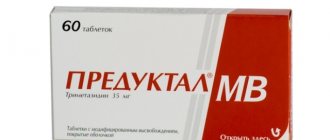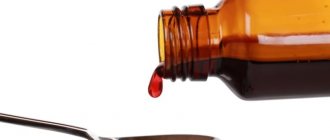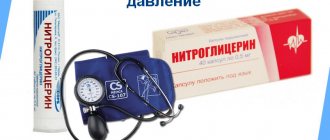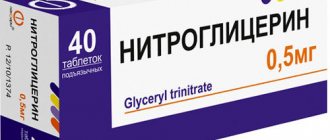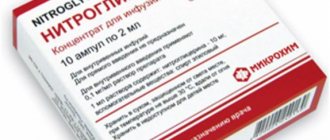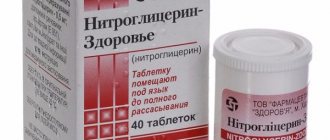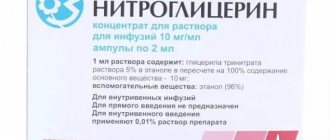0
Author of the article: Marina Dmitrievna
2017.12.15
3 264
Drugs
Validol and nitroglycerin are medications used in cardiological practice for the treatment of cardiovascular disorders.
Drug packaging in a pharmacy
Attention! In the pharmacological classification of ATC, validol is designated by the code C01EX, and nitroglycerin by C01DA02.
When and what medicine is best to take
In what cases are Validol and Nitroglycerin taken? The first drug contains valerian ether and menthol. The medicine has a slight sedative effect and quickly dilates the coronary vessels.
What else does Validol help with? With it you can:
- Eliminate minor pain in the heart. Most people who suffer from chronic cardiac diseases keep Validol in their medicine cabinet as a first aid medicine.
- Calm down during hysteria and neurotic conditions.
It should be admitted that Validol is a very weak medicine; it is practically menthol lozenges.
What does Validol help with? This drug can eliminate pain near the heart, which is caused by vegetative-vascular dystonia, as well as neuroses, since it has a slight calming effect on the nervous system, and its vasodilating effect is too weak and occurs reflexively.
But “Nitroglycerin,” on the contrary, has proven itself well as a “reactive” medicine for patients who have developed acute ischemic heart pain. The medicine can eliminate unpleasant sensations in a short time and acts as a standard with which all modern means suitable for solving such problems are compared.
The therapeutic effect of nitroglycerin is that it sharply expands the capillaries, from which the heart itself is nourished. Thanks to this complex effect on the myocardium and surrounding vessels, it ensures durability and immediate therapeutic effect.
Validol or nitroglycerin, which is better?
Periodically looking into our medicine cabinet, we brush away the cobwebs in the corners and find a bunch of expired medications that could use updating. Here we try to remember in what cases validol and nitroglycerin are taken. Ordinary people do not always clearly understand the difference between nitroglycerin and validol.
The effectiveness of validol for heart problems is questionable; its pharmacological activity is weakly expressed, but it has practically no side effects. Nitroglycerin is a much more effective drug in the case of cardiovascular diseases.
They differ from each other in activity, profile of indications and side effects.
Validol or nitroglycerin: when to take them?
Validol contains valeric acid ester and menthol. Validol has a slight sedative effect and quite quickly dilates the coronary arteries. Thanks to these properties it can:
- Eliminate mild heart pain. Many patients suffering from chronic forms of cardiac diseases take validol as a first aid remedy.
- Calm the nervous system during mild hysteria and neuroses.
It should be admitted that the good old validol medicine is quite weak - almost mint candies.
It is correct to use it to relieve various neuroses and hysterics (washing dishes - a nail broke, a manicure got ruined, Spartak lost again).
This is where validol can help if you put it under the tongue, that is, as doctors cleverly put it - sublingually. Just look and you will feel better, the tension will subside thanks to the sedative effect, and while you come to your senses, you can touch up your manicure.
It is able to relieve pain near the heart caused by vegetative-vascular dystonia and neuroses, since it has a mild sedative effect on the central nervous system, and its vasodilating effect is too weak and is caused reflexively.
But nitroglycerin has proven itself to be an immediate means of helping people who suddenly develop severe ischemic heart pain. Nitroglycerin can very quickly relieve heart pain and is a kind of standard with which all new drugs invented by pharmacists that are intended to solve such problems are compared.
The therapeutic effect of nitroglycerin is that it quickly expands the coronary (coronary) vessels, from which the heart itself is nourished. And the heart, experiencing oxygen starvation as a result of spasm of these vessels, responds to us with pain.
In addition, nitroglycerin redistributes blood flow in the heart in the direction of sections that have undergone ischemia, due to which the contractility of the organ improves.
Thanks to this complex effect on the myocardium and surrounding vessels, the durability and immediate effect of using nitroglycerin is ensured.
Well, if you need a short answer when to drink validol and when to take nitroglycerin, then we will answer:
Take Validol for heart pain of a neurotic nature (i.e., from anxiety) and for mild forms of heart disease. Take nitroglycerin for angina attacks and other serious diseases of the cardiovascular system.
In the case of angina pectoris, the question of which is better - validol or nitroglycerin - is obvious.
Validol can only help with mild angina, and in the case of stable or severe unstable angina, nitroglycerin should be used.
But it cannot be used for anxiety disorders, neurogenic pain, affective disorders and pregnancy. Before using nitroglycerin for the first time, you should consult your doctor.
How to take validol and nitroglycerin?
Take validol in liquid form or a tablet under the tongue to reduce anxiety.
The fastest reaction of the body can be achieved precisely when taken under the tongue, where there are especially many receptors sensitive to menthol.
But if there is any pressing or other pain in the chest, then you should immediately call a doctor to see the person. Only early medical care can save the lives and maintain the health of people suffering from cardiovascular pathologies.
Nitroglycerin should be taken sublingually (under the tongue). It begins to act almost instantly.
If the attack is not relieved by the first tablet of the drug, then after 5-10 minutes you can use the second, but no more, since the patient may experience agitation or weakness, pale skin, nausea, and a sharp drop in blood pressure. In other words, a collapse may occur, which is no less dangerous than the angina attack itself.
If even after this the pain does not go away, then it is necessary to call emergency cardiac care, since there are signs of a developing myocardial infarction.
You should also not use nitroglycerin under the tongue “just in case” to avoid another heart attack.
If you take this remedy too often, then after a while many people develop an addiction to nitroglycerin, and it loses its effectiveness, which is restored after a certain pause in use.
If a particular nitro-drug has stopped working, the doctor must find an alternative.
Can validol and nitroglycerin be taken together?
Yes, this is completely acceptable.
Although validol dilates blood vessels and has a calming effect on the body, it is practically useless for angina pectoris. But still, you should not immediately abandon its use.
Indeed, during an angina attack, a person not only experiences chest pain, but also fear of death, since the pain can be very severe. Validol will help to calm the growing fear.
Nitroglycerin can quickly stop a heart attack, but at the same time it causes nausea and headache, which can also be relieved with validol. Therefore, in this case, it is best to use nitroglycerin and validol at the same time.
What is the difference between validol and nitroglycerin?
Both drugs have long been in use and are familiar to people, but despite this, there will always be those who are perplexed by the question of what is the difference between validol and nitroglycerin. And the difference is significant, from indications, dosage, to side effects.
Side effects and contraindications
Since validol does not contain monosaccharides, it can be given to patients who also suffer from diabetes. Patients tolerate it well, with only occasional side effects:
- angioedema;
- dizziness;
- hives;
- epigastric pain;
- vomit.
All of these symptoms do not require medical intervention and go away on their own in not too long a time.
Nitroglycerin has more side effects, but it is much stronger than validol. Here's what it can cause:
- dizziness;
- dysregulation of blood circulation (increased heart rate, decreased blood pressure);
- redness;
- nausea and vomiting;
- weakness;
- cardiac arrhythmia;
- fainting;
- allergic skin reaction;
- a sharp drop in blood pressure with increased signs of angina.
These effects are caused by a sudden dilation of cerebral blood vessels, which causes excess blood to flow to the brain.
But the effect of nitroglycerin is quite short, and when it ends, the side effects go away.
At the very first dose or after increasing the dose, people with coronary artery disease may begin to experience symptoms of stable angina. Sometimes a paradoxical redistribution of blood in the body occurs.
Those patients in whom nitroglycerin causes a persistent throbbing headache should find an alternative type of nitro drugs.
Sometimes long-term use of nitroglycerin can cause visual disturbances - people begin to see blue or yellow circles before their eyes. If a person has normal vision, then these effects will pass without a trace for him, but if he has glaucoma, there can be significant problems. Therefore, when prescribing the drug and its dose, the doctor must take into account such factors.
Source: https://cardiologiya.com/lecheniye/preparaty/validol-ili-nitrogliczerin-chto-luchshe.html
How to take Validol
Validol tablets are recommended for patients to dissolve under the tongue. You can take the medication regardless of meals, three times a day. The duration of therapy is determined by a specialist individually for each patient.
If no positive pharmacological effect is observed within 10-15 minutes after resorption of the drug, the patient should consult a doctor to prescribe another medication. If you feel sick while riding in public transport, it is enough to take Validol once.
Instructions for use
As mentioned above, validol is administered sublingually. It is taken regardless of meals three times a day, one tablet. The duration of treatment by the doctor is determined individually for each patient. If the desired effect does not occur within 20 minutes after absorption of the tablets, the patient should take any other drug as recommended by the therapist.
Validol is sometimes prescribed to expectant mothers in the 1st trimester of pregnancy to relieve symptoms of toxicosis. It is able to eliminate minor nausea, hypersalivation, flatulence, pain in the gastrointestinal tract and vertigo syndrome.
The use of the substance in pregnant patients should only be carried out under medical supervision, with constant monitoring of heart rate and blood pressure.
The use of medication during lactation is possible if the expected benefit from breastfeeding is higher than the potential risk to the baby. In medicine, there is no reliable data on the penetration of active ingredients into breast milk, so it is better not to use this drug during lactation.
As for nitroglycerin, when cardiac pain (angina) occurs or before any stress that can cause such an attack, take one to several capsules. Due to the high dosage, you should not take more than one tablet at a time.
Angina attack
The same applies to acute myocardial failure (left ventricular failure) or heart attack, but treatment in these cases should be under medical supervision. If necessary, you can take an additional tablet after 10 minutes.
If the drug is in capsules, patients should chew them and keep the contents in their mouth for as long as possible. The capsule body can be swallowed or spat out. The duration of treatment is determined by the attending physician.
Use of Nitroglycerin
To prevent complications, you must use the drug as prescribed by your doctor. According to the instructions for use for Nitroglycerin tablets, the dosage is 1 piece.
It is kept in the oral cavity until completely dissolved, without swallowing. Nitroglycerin should be used immediately when the first symptoms of an angina attack occur or before intended physical exercise.
In case of stable angina pectoris, the effect may also occur with a lower dosage; in this situation, the remainder of the tablet that has not dissolved should be spat out. In most cases, improvement is noted within the first 3 minutes of taking Nitroglycerin. If the angina attack is not eliminated within five minutes, you need to take 1 more tablet.
If there is no pharmacological effect after using 2 Nitroglycerin tablets, you should immediately consult a doctor.
The spray is administered on or under the tongue, preferably in a sitting position, while holding your breath. After injection, the medicine is not swallowed immediately, but is held for a few seconds.
To avoid complications, Nitroglycerin must be taken as prescribed by a doctor. When the first symptoms of angina occur, 1-2 dosages of the spray are administered.
If necessary, another injection is likely to be administered, but no more than three doses within 15 minutes. If after using 3 doses within this time the condition does not improve, it is important to consult a doctor. The maximum single concentration is 3 doses of spray.
If the prescription for the use of “Nitroglycerin” is considered to be the prevention of angina pectoris, the medication is administered 1 dose ten minutes before possible exercise or stress. It is not necessary to shake the spray before use.
Composition, mechanism of action of the drug
Validol helps with heart pain, as it contains valeric acid, which has a sedative effect, menthol, which weakens vascular spasm, as well as substances that enhance the synthesis and subsequent release of enkephalins and endorphins. They help reduce pain.
Validol has the ability to:
- Relieve mild pain.
- Increase the lumen of blood vessels.
- Reassure the patient.
Such influences occur due to the fact that the effect of individual components of the drug enhances the synthesis and release into the bloodstream of certain hormones that reduce pain sensitivity and stabilize the activity of the nervous system.
Arteries and veins dilate, and the flow of oxygen and trophic substances to the myocardium increases. Cardiac arrhythmia disappears and cardiac conduction normalizes. Such effects are short-lived, so more serious treatment is required as the disease progresses. Moreover, it is not permissible to use the drug when the patient’s life is threatened by the development of severe complications.
Validol for the heart, despite its simplicity and versatility, is still advisable to take only after consulting a doctor. It is also necessary to strictly observe the dosage. It should not be drunk haphazardly or in large quantities.
If discomfort develops, one tablet is placed in the sublingual area and waited for it to completely dissolve. It is allowed to use no more than two pieces at a time, and the daily dose should not be more than four.
This is due to the fact that the drug has a minimum of side effects, but, nevertheless, they are occasionally observed. They can manifest themselves in the form of nausea, darkening of the eyes, severe lacrimation, and tremors.
Such influences do not pose a threat to health, but must be taken into account when performing daily professional duties.
Is it possible to take Validol and Nitroglycerin together?
Yes, this is allowed. Although Validol dilates capillaries and has a sedative effect on the body, it is useless for angina pectoris. But it is still not recommended to immediately abandon its use. Since during an angina attack the patient not only experiences chest pain, but also fear of death.
Validol will help eliminate this fear. Nitroglycerin can quickly neutralize a heart attack, but it provokes nausea and headaches, which can also be removed with Validol. Therefore, in this situation, it is best to use these medications at the same time.
What are the differences between medications
What is the difference between Validol and Nitroglycerin? Both medications have been known to everyone for a long time.
But despite this, there will always be those people for whom the question of what is the difference between “Validol” and “Nitroglycerin” puts them in a difficult position. And the difference is significant, starting from the purpose, dose, ending with adverse reactions.
When to take nitroglycerin and when to take validol
Periodically looking into our medicine cabinet, we brush away the cobwebs in the corners and find a bunch of expired medications that could use updating. Here we try to remember in what cases validol and nitroglycerin are taken. Ordinary people do not always clearly understand the difference between nitroglycerin and validol.
The effectiveness of validol for heart problems is questionable; its pharmacological activity is weakly expressed, but it has practically no side effects. Nitroglycerin is a much more effective drug in the case of cardiovascular diseases.
They differ from each other in activity, profile of indications and side effects.
When are medications prescribed?
When to take Nitroglycerin and when to take Validol? Indications for use vary. Here are the situations in which it is necessary to use Validol:
- Stable mild form of angina (attacks of sudden chest pain that develop as a result of an acute lack of blood supply to the heart muscle).
- Painful sensations of various etiologies.
- Insomnia (a pathological condition in which the process of onset and maintenance of sleep is disrupted).
- Neurotic disorders (a collective name for a group of functional psychogenic reversible disorders that tend to be protracted).
- Kinetosis (motion sickness disease develops in people when riding on ships, cars, planes, and less often on a train).
- Migraine (the primary form of headache, the symptoms of which are periodic attacks of moderate to severe headaches).
- Hysterical disorder (personality disorder characterized by an inexhaustible need for attention, unstable self-esteem, overestimation of the importance of gender, feigned behavior).
- Panic attack (an anxiety attack accompanied by unreasonable fear, combined with various symptoms).
- Nausea.
What is better - "Validol" or "Nitroglycerin"? The second medication is considered an active ingredient for many nitro drugs:
- For acute angina pain, it can be used in the form of sublingual tablets, as well as a spray or intravenously.
- In acute myocardial infarction (a focus of ischemic necrosis of the myocardium, which occurs after an acute violation of the coronary circulation).
- Myocardial insufficiency (impaired functioning of the heart muscle).
- Hypertensive crisis (a serious illness that is triggered by an increase in blood pressure, manifested clinically and requiring an immediate decrease in blood pressure to limit target organ damage).
Which is better, “Validol” or “Nitroglycerin”, interests many people.
What's better -
In what cases is it best to use Validol, and in what cases is it best to use Nitroglycerin? As a rule, people do not always see the difference between these drugs. The effectiveness of Validol for heart disease is very doubtful; its pharmacological activity is weakly expressed, but there are practically no side effects. What is better – “Validol” or “Nitroglycerin” – for heart pain?
The second medicine is considered a more effective remedy for cardiovascular diseases. They differ from each other in activity, as well as in the range of indications and side effects.
When and what medicine is best to take
In what cases are “Validol” and “Nitroglycerin” taken? The first drug contains valerian ether and menthol. The medicine has a slight sedative effect and quickly dilates the coronary vessels.
What else does “Validol” help with? With it you can:
- Eliminate minor pain in the heart. Most people who suffer from chronic cardiac diseases keep Validol in their medicine cabinet as a first aid medicine.
- Calm down during hysteria and neurotic conditions.
It should be admitted that “Validol” is a very weak medicine; it is practically menthol lozenges.
What does Validol help with? This drug can eliminate pain near the heart, which is caused by vegetative-vascular dystonia, as well as neuroses, since it has a slight calming effect on the nervous system, and its vasodilating effect is too weak and occurs reflexively.
But “Nitroglycerin,” on the contrary, has proven itself well as a “reactive” medicine for patients who have developed acute ischemic heart pain. The medicine can eliminate unpleasant sensations in a short time and acts as a standard with which all modern means suitable for solving such problems are compared.
The therapeutic effect of nitroglycerin is that it sharply expands the capillaries, from which the heart itself is nourished. Thanks to this complex effect on the myocardium and surrounding vessels, it ensures durability and immediate therapeutic effect.
How to take Validol
Validol tablets are recommended for patients to dissolve under the tongue. You can take the medication regardless of meals, three times a day. The duration of therapy is determined by a specialist individually for each patient.
If no positive pharmacological effect is observed within 10-15 minutes after resorption of the drug, the patient should consult a doctor to prescribe another medication. If you feel nauseous while riding in public transport, it is enough to take Validol once.
Application of “Nitroglycerin”
To prevent complications, you must use the drug as prescribed by your doctor. According to the instructions for use for Nitroglycerin tablets, the dosage is 1 piece.
It is kept in the oral cavity until completely dissolved, without swallowing. Nitroglycerin should be used immediately when the first symptoms of an angina attack occur or before intended physical exercise.
In case of stable angina pectoris, the effect may also occur with a lower dosage; in this situation, the remainder of the tablet that has not dissolved should be spat out. In most cases, improvement is noted within the first 3 minutes of taking Nitroglycerin. If the angina attack is not eliminated within five minutes, you need to take 1 more tablet.
If there is no pharmacological effect after using 2 Nitroglycerin tablets, you should immediately consult a doctor.
The spray is administered on or under the tongue, preferably in a sitting position, while holding your breath. After injection, the medicine is not swallowed immediately, but is held for a few seconds.
To avoid complications, Nitroglycerin must be used as prescribed by a doctor. When the first symptoms of angina occur, 1-2 dosages of the spray are administered.
If necessary, another injection is likely to be administered, but no more than three doses within 15 minutes. If after using 3 doses within this time the condition does not improve, it is important to consult a doctor. The maximum single concentration is 3 doses of spray.
If the prescription for the use of “Nitroglycerin” is considered to be the prevention of angina pectoris, the medication is administered 1 dose ten minutes before possible exercise or stress. It is not necessary to shake the spray before use.
Is it possible to take Validol and Nitroglycerin together?
Yes, this is allowed. Although Validol dilates capillaries and has a sedative effect on the body, it is useless for angina pectoris. But it is still not recommended to immediately abandon its use. Since during an angina attack the patient not only experiences chest pain, but also fear of death.
“Validol” will help eliminate this fear. Nitroglycerin can quickly neutralize a heart attack, but it provokes nausea and headaches, which can also be removed with Validol. Therefore, in this situation, it is best to use these medications at the same time.
What are the differences between medications
What is the difference between “Validol” and “Nitroglycerin”? Both medications have been known to everyone for a long time.
But despite this, there will always be those people for whom the question of what is the difference between “Validol” and “Nitroglycerin” puts them in a difficult position. And the difference is significant, starting from the purpose, dose, ending with adverse reactions.
When are medications prescribed?
When to take Nitroglycerin and when to take Validol? Indications for use vary. Here are the situations in which you need to use Validol:
- Stable mild form of angina (attacks of sudden chest pain that develop as a result of an acute lack of blood supply to the heart muscle).
- Painful sensations of various etiologies.
- Insomnia (a pathological condition in which the process of onset and maintenance of sleep is disrupted).
- Neurotic disorders (a collective name for a group of functional psychogenic reversible disorders that tend to be protracted).
- Kinetosis (motion sickness disease develops in people when riding on ships, cars, planes, and less often on a train).
- Migraine (the primary form of headache, the symptoms of which are periodic attacks of moderate to severe headaches).
- Hysterical disorder (personality disorder characterized by an inexhaustible need for attention, unstable self-esteem, overestimation of the importance of gender, feigned behavior).
- Panic attack (an anxiety attack accompanied by unreasonable fear, combined with various symptoms).
- Nausea.
What is better – “Validol” or “Nitroglycerin”? The second medication is considered an active ingredient for many nitro drugs:
- For acute angina pain, it can be used in the form of sublingual tablets, as well as a spray or intravenously.
- In acute myocardial infarction (a focus of ischemic necrosis of the myocardium, which occurs after an acute violation of the coronary circulation).
- Myocardial insufficiency (impaired functioning of the heart muscle).
- Hypertensive crisis (a serious illness that is triggered by an increase in blood pressure, manifested clinically and requiring an immediate decrease in blood pressure to limit target organ damage).
Which is better, “Validol” or “Nitroglycerin”, interests many people.
Adverse reactions of Validol
The drug does not contain monosaccharides, so it can be given to people who suffer from diabetes. Patients, as a rule, tolerate it well, sometimes there are negative effects:
- Angioedema (violation of vascular tone and blood circulation in a separate place or in the entire circulatory system at once).
- Dizziness.
- Nettle rash.
- Epigastric pain.
- Vomit.
All of the above symptoms do not require treatment and go away on their own in a short time.
Negative effects of “Nitroglycerin”
But “Nitroglycerin” has more side effects, but it also acts somewhat stronger than “Validol”. Negative effects that the drug can provoke:
- Dizziness.
- Redness.
- Vomiting.
- Cardiac arrhythmia (a pathological condition in which disturbances in the frequency, rhythm and sequence of excitation and contraction of the heart occur).
- Nausea.
- Syncope (an attack of short-term loss of consciousness caused by a temporary disruption of cerebral blood flow.).
- Skin allergic manifestations.
- A sharp drop in blood pressure with increased signs of angina.
These negative phenomena are provoked by a sharp expansion of the cerebral capillaries, which causes a lot of blood to flow to the brain. But the effect of “Nitroglycerin” is short-lived, and when it ends, side reactions also disappear.
Restrictions on taking Validol
Tablets are not prescribed in pediatrics or in cases of individual intolerance to the active substance. With extreme caution, Validol is prescribed to people with respiratory failure and bronchial asthma.
This medicine is not recommended for patients with acute myocardial infarction.
Contraindications to Nitroglycerin
The use of the drug is prohibited for the following pathological conditions, which include:
- Arterial hypotension (a long-term condition of the body characterized by low blood pressure and various autonomic disorders: decreased body temperature, sweating of the feet and palms, pallor).
- Constrictive pericarditis (fibrous thickening of the pericardial layers and obliteration of the pericardial cavity, leading to compression of the heart and impaired diastolic filling of the ventricles).
- Compression of the heart.
- Hypertrophic cardiomyopathy (primary isolated myocardial damage, characterized by hypertrophy of the ventricles (usually the left) with a reduced or normal volume of their cavities).
- Increased intracranial pressure.
- Angle-closure glaucoma with increased intraocular pressure (a pathological process that leads to injury to the optic nerve).
Before starting Nitroglycerin therapy, it is important to ensure that there are no contraindications.
Comparison of “Validol” and “Nitroglycerin” during pregnancy and breastfeeding
The drug “Validol” is sometimes recommended to women during an interesting situation in the first three months to alleviate early toxicosis. According to the responses of expectant mothers, the tablets are really good at neutralizing nausea, as well as increased salivation and preventing increased gas formation.
The use of medication in pregnant women should only be done under the supervision of a doctor, and it is important to monitor pulse and blood pressure. During lactation, you can use Validol, but only under strict medical indications.
Nitroglycerin can be used during pregnancy. But this is only in a situation where there will be more benefit from it for the unborn child than harm. While using it, you must stop breastfeeding. Therefore, it will not work to say which is better - “Validol” or “Nitroglycerin” - during pregnancy.
Source: https://FB.ru/article/471646/chto-luchshe—validol-ili-nitroglitserin-sravnenie-preparatov-pokazaniya-k-primeneniyu-mehanizm-deystviya
Adverse reactions of Validol
The drug does not contain monosaccharides, so it can be given to people who suffer from diabetes. Patients, as a rule, tolerate it well, sometimes there are negative effects:
- Angioedema (violation of vascular tone and blood circulation in a separate place or in the entire circulatory system at once).
- Dizziness.
- Nettle rash.
- Epigastric pain.
- Vomit.
All of the above symptoms do not require treatment and go away on their own in a short time.
Negative effects of Nitroglycerin
But “Nitroglycerin” has more side effects, but it also acts somewhat stronger than “Validol”. Negative effects that the drug can provoke:
- Dizziness.
- Redness.
- Vomiting.
- Cardiac arrhythmia (a pathological condition in which disturbances in the frequency, rhythm and sequence of excitation and contraction of the heart occur).
- Nausea.
- Syncope (an attack of short-term loss of consciousness caused by a temporary disruption of cerebral blood flow.).
- Skin allergic manifestations.
- A sharp drop in blood pressure with increased signs of angina.
These negative phenomena are provoked by a sharp expansion of the cerebral capillaries, which causes a lot of blood to flow to the brain. But the effect of Nitroglycerin is short-lived, and when it ends, side reactions also disappear.
Contraindications to Nitroglycerin
The use of the drug is prohibited for the following pathological conditions, which include:
- Arterial hypotension (a long-term condition of the body characterized by low blood pressure and various autonomic disorders: decreased body temperature, sweating of the feet and palms, pallor).
- Constrictive pericarditis (fibrous thickening of the pericardial layers and obliteration of the pericardial cavity, leading to compression of the heart and impaired diastolic filling of the ventricles).
- Compression of the heart.
- Hypertrophic cardiomyopathy (primary isolated myocardial damage, characterized by hypertrophy of the ventricles (usually the left) with a reduced or normal volume of their cavities).
- Increased intracranial pressure.
- Angle-closure glaucoma with increased intraocular pressure (a pathological process that leads to injury to the optic nerve).
Before starting Nitroglycerin therapy, it is important to ensure that there are no contraindications.
Comparison of "Validol" and "Nitroglycerin" during pregnancy and breastfeeding
The drug "Validol" is sometimes recommended to women during an interesting situation in the first three months to alleviate early toxicosis. According to the responses of expectant mothers, the tablets are really good at neutralizing nausea, as well as increased salivation and preventing increased gas formation.
The use of medication in pregnant women should only be done under the supervision of a doctor, and it is important to monitor pulse and blood pressure. During lactation, you can use Validol, but only under strict medical indications.
Nitroglycerin can be used during pregnancy. But this is only in a situation where there will be more benefit from it for the unborn child than harm. While using it, you must stop breastfeeding. Therefore, it will not work to say which is better - “Validol” or “Nitroglycerin” - during pregnancy.


